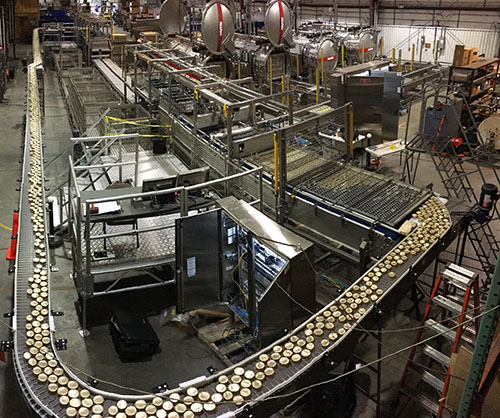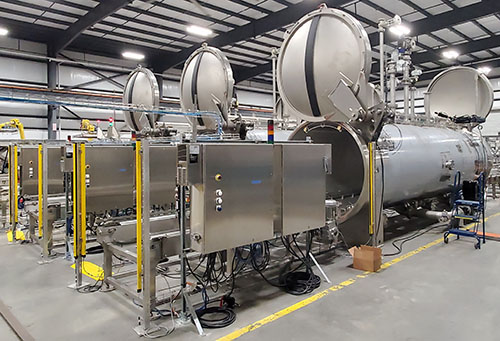This article was published in the March 2023 issue of Pet Food Processing. Read it and other articles from this issue in our March digital edition.
The calculation of Return on Investment (ROI) has changed dramatically over the last couple of years. Beyond figuring pure financial costs and calculations, ROI must also meet the technical demands of an application currently and in the future. Jeff Arthur, technical sales director, Allpax, Covington, La., outlines this as a solution that provides for the most efficient operation from a manpower, utilities and maintenance standpoint.
Contemplating equipment purchases demands strong partnerships and clear intent. Because each purchase will impact a number of departments, every ROI discussion should include a well-rounded group of stakeholders. This could include engineering, maintenance, production, regulatory, food safety, QA and QC, HR, procurement, sales and marketing — each providing insight to ensure all aspects are covered.
“The selection of a piece of equipment that could drastically affect the number of operators to run a process is not always factored into a plant’s ROI,” said Brian Gifford, PE, CRB.
With the in-house team in place, it’s time to identify the best supplier partner to ensure the right support will be there when it’s needed. Supplier partners must be large enough, capable of working through supply chain challenges, and have the ability to provide good service to help plant operations achieve ROI expectations.
Coming to the table
The variability of labor and raw material costs is one point on which all interested parties often agree. As raw material costs increase, so does the importance of reducing yield loss. As labor rates rise, manufacturers want the ability to do the same amount of work with fewer people, triggering the need for more automation. Investing in automation could reduce the risk of operator failure, but maintainability over time with parts availability or cost, labor needs, and original equipment manufacturer (OEM) support should also be considered.
Arthur recommended processors consider automated solutions to minimize the reliance on operator labor and minimize downtime. Brian Gifford, PE, mechanical engineer, CRB, St. Louis, echoed this by saying the more operator intervention required — especially with new operators — the more susceptible a company is to loss in yield or quality failures that can equal loss in product. In plants where wages must rise to attract and retain talent, manufacturers often consider automation to be a strong ROI factor. This can be a double-edged sword, however, because as automation increases, the risk of mechanical failure also rises, requiring more people capable of working on these elements.
Cleaning and production inevitably require some level of human intervention, and maintaining a consistent workforce is an ongoing challenge for many. Because human error is a primary reason for equipment failure, operator training remains very important. The better operators understand the equipment, the more efficient the process. This also leads to a subsequent reduction in maintenance and service required.
“Automation is always a key conversation at the beginning of a project, but there’s no such thing as a fully automated piece of equipment that doesn’t require operator intervention,” Gifford said. “The selection of a piece of equipment that could drastically affect the number of operators to run a process is not always factored into a plant’s ROI.”
Maintenance considerations
Each piece of equipment requires preventive maintenance, which varies depending on how the equipment was designed. Maintenance directly affects the operating or uptime efficiency of the equipment or system, as well as the expected payback. This makes a robust preventive maintenance (PM) plan important. Having this plan fully vetted can determine a maintenance budget to understand what’s required for each PM task, which will require a certain amount of downtime to execute. That downtime, along with the labor and raw materials to perform the PM tasks, should also be included in ROI equations.
“There will be failures even with the best PM plan, but this is harder to quantify,” Gifford said. “Allowance can typically be assumed and input into the ROI equation for catastrophic failures. The impact of maintenance unique to the piece of equipment should be investigated and considered by the owner and design team to ensure downtime is limited due to failure or preventative maintenance tasks.”

Allpax batch retort systems are ready for field installation and startup prior to leaving the factory, which allows processors to have a more efficient and timely equipment installation. (Source: Allpax)
From a seller’s perspective, Allpax has seen technical buyers become keener about the availability of replacement parts and the ability to procure more parts, particularly electrical parts, from multiple and local sources versus only relying on the OEM. Off-the-shelf items are typically cheaper and could reduce the overall capital cost of the project, if there’s warehouse space to store the parts.
But an off-the-shelf approach must be investigated closely because the market is constantly changing. Items available off the shelf today can quickly change tomorrow, requiring an adaptable strategy for spare parts inventory. Maintenance managers must understand which parts have long lead times and ensure they have a suitable inventory to support failures and limit downtime.
“If an OEM does not have the ability or track record of providing good aftermarket support, this should be a huge red flag,” Arthur said.
Cleaning costs
While the tracking of parts and labor costs appears more straightforward, cleaning costs can be harder to ascertain. Cleaning requirements differ depending on the equipment and the equipment manufacturer, as well as how it should be cleaned and how often. Each piece of equipment requires varying amounts of water — steam, power or chemical — for cleaning, along with the utilities to operate electrical and generate steam and compressed air to support the process.
Raw materials used in equipment cleaning such as chemicals, natural gas, water and salt should also be considered in addition to the cost to generate utilities and the cost of operators to run the cleaning process — all of which add up to a total cost per cleaning cycle, further reducing profit.

When preparing a new system for a processing plant, Allpax plans a factory acceptance test (FAT) that mirrors the intended equipment layout at the customer’s plant. (Source: Allpax)
Even more modern clean-in-place (CIP) equipment will include parts that need to be broken down for cleaning. Depending on the vendor and the equipment, the amount of time needed for breakdown, cleaning-out-of-place (COP) and reassembly will vary. Lines that require cleaning between runs of different products will also drastically impact the throughput of the plant.
Old versus new
Another consideration is whether to maintain old equipment or buy new. It’s a choice dependent on the perspective, needs, incentives and desired timeline. Older equipment is known for being labor intensive, requiring more manual intervention for cleaning. It may also produce product varying in consistency, which can lead to quality testing failures. For example, a tank with product sticking to the sidewall cannot be transferred and could result in the loss of product — another incentive to invest in new equipment, Gifford said.
He recommended asking if the purchase replaces existing equipment or if it’s an addition/expansion to the facility. Does the new equipment match the existing throughput or is more throughput required? If scale-up is needed, how much? With these answers in mind, a consultant like CRB would then determine if the company was happy with its current suppliers. If an evaluation of new suppliers is recommended, are there any preferred vendors? Lastly, are there any grievances on existing equipment that the purchase of new equipment could alleviate?
“We work to understand the current grievances for the existing equipment and then put our focus on upgrades,” Gifford said. “We want to understand any aspect of the equipment that causes any failures on a regular basis, downtime and difficulties in cleaning. This could be something the client notices while the equipment is running or something noticed on a walk-through that can be improved.”
Lessons learned
When calculating the total cost of ownership, Arthur suggested looking at the upfront capital cost for the machinery along with the costs to install. This can include startup/commissioning, floor space, operating efficiency, the quantity and type of operating labor, the quantity and type of maintenance costs including labor, utilities and consumables (lubricants and chemicals), replacement and rebuild parts, and OEM service support. Costs to change over and/or convert to handling future needs might also come into play.
“If an OEM does not have the ability or track record of providing good aftermarket support, this should be a huge red flag,” said Jeff Arthur, Allpax.
“Be careful about selecting the most inexpensive solutions, since often these systems do not provide the best longer-term payback,” Arthur continued. “A well-planned and thorough factory acceptance test (FAT) is essential for optimum ROI. A new automated batch retort system should be 100% ready for installation and commissioning in the field by the end of the FAT. This level of completion results in a much faster and easier startup at the plant. This leads to more products being produced faster, which is what achieving ROI requires.”
The selection of the right partner, one known for a commitment to continuously improving their products and services, is also instrumental in getting the most out of an investment. The right supplier or partner should offer easy accessibility in terms of distance and language, along with deep customer service capabilities. This includes mechanical and controls flexibility, upgrade capabilities, and the ability to proactively support such efforts down the road, especially considering how rapidly technology is changing. Rushing into construction with too little detail on process equipment has a major effect on the facility design and infrastructure, Gifford said.
“Invest as much as possible in early work,” he concluded. “The more that can be invested in early testing, design details, etc., the more real the ROI equation can be. This can also save a large amount of money in capital projects. The more information you have on your equipment requirements, the easier it is to design infrastructure and severely reduce scope gaps during construction.”
Read more about pet food and treat processing on our Operations page.




